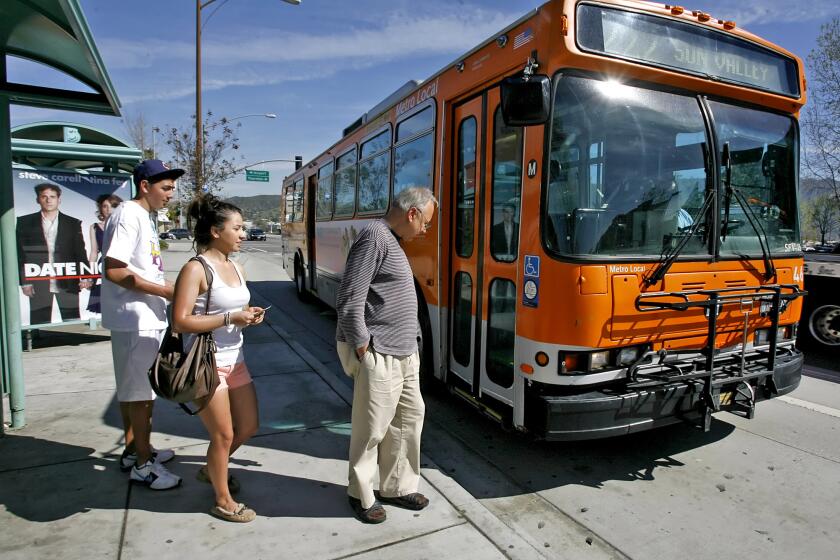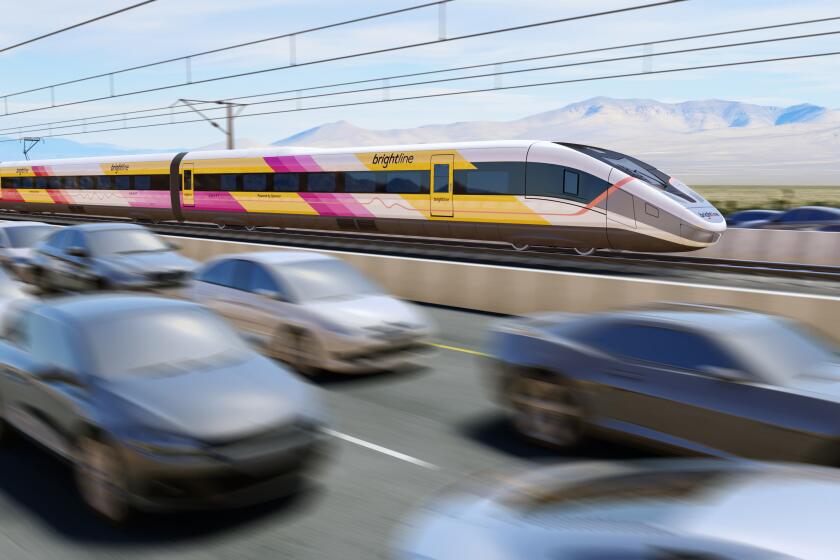Groups Pursue Aspirations for a Green River
Is a river without water really a river? Much of the year the Los Angeles River would be dry if it weren’t for small outflows from water treatment plants.
But when the rains come, torrents of water rush into the concrete flood control channels of the river.
For years the Los Angeles River has been treated mostly as a drainage ditch, given backdoor status by the 13 cities it passes on its 51-mile run from the west San Fernando Valley to the ocean.
Now, growing interest in the potential of the river has spawned the Los Angeles River Greenway Project, a plan to take advantage of the bits and pieces of bicycle paths, parks and natural lands that already exist--such as Sepulveda Basin and Griffith and Elysian parks--and link them with a parkway.
At its most ambitious, the parkway along the river would become the backbone for an open-space network for the region connecting the San Fernando Valley to the ocean near Long Beach.
The first new pocket park--envisioned as a gem in what could become an emerald necklace for the city--is the Elysian Valley Gateway Park, located beside the river where it crosses under the Glendale Freeway in a neighborhood historically known as Frogtown.
This stretch of the river remains semi-natural and supports willows, rushes and wildlife in a wetlands that exists through the year. It’s part of the 12 miles of riverbed where a high water table prevented construction of a concrete bottom.
The park opened in July 1995 on a third of an acre purchased for $200,000 by the Trust for Public Land, a national nonprofit organization that acquires land for public open space. The tree-shaded park is open to the river and a bikeway that extends for seven miles along the levee. The bikeway is now being landscaped with trees and eventually will extend west to the Sepulveda Basin and south into downtown Los Angeles.
Other projects underway along the river include a seven-acre wetland in Long Beach at the south end of a bicycle and equestrian trail that runs from the confluence of the Rio Hondo; a seven-acre multiuse park and flood-water holding basin in Bellflower; and a 30-acre wetland restoration project at Dominguez Gap.
Historically, the Los Angeles River spread across a wide flood plain dotted with marshes and ponds and shifted its course periodically. The river flowed out to Santa Monica Bay until severe flooding in 1825 changed its course to San Pedro Bay.
In the 1930s, the Army Corps of Engineers began to tame the seasonal floods that were a fact of life in the Los Angeles area. After flooding in 1938 killed 59 people, the battle against the river and its tributaries intensified. Today they are encased in a 400-mile regional flood-control system.
The battle continues with a $312-million project to raise the walls of the main Los Angeles River channel for 20 miles from downtown to the ocean. Advocates of a less-concrete river hope the project can be stopped and the money spent on a new approach to flood control that would restore watershed and natural river bottom.
Regardless of the outcome, the parkway project stands on its own. Esther Feldman, director of the Trust for Public Land field office in Los Angeles, sees the project as a major opportunity to tie the vast Los Angeles region together.
“It can serve both to unite communities while providing access to recreational space that’s an escape from an urban area,” Feldman said.
The group wants to acquire more riverside parcels with $16 million from a $319-million county parks bond issue that will appear on the November ballot.
The American Society of Landscape Architects is collaborating with the trust on the Greenway Vision project, which takes as its inspiration an earlier idea for the Los Angeles River. In 1930 a landscape architecture firm run by the sons of Frederick Law Olmstead, designer of New York’s Central Park, proposed purchasing a wide swath of land along the river to create a system of “pleasureways” interconnected with parks on the flood plain.
Nothing came of their plan, but those working on ideas for the river now are aware of the history and are trying to revive the spirit of it.
A workshop in April brainstormed ideas for transforming potentially available sites along the river--flood control and power-line easements, abandoned industrial land--into parks, playgrounds, habitat areas and residential and commercial projects connected by trails and bridges.
One of the favored models for the workshop was the River Walk that transformed downtown San Antonio by creating a waterfront for outdoor dining and strolling.
“Just because we don’t have water for much of the year doesn’t mean we couldn’t create an area like the San Antonio River Walk,” says Cynthia D’Agosta of the Trust for Public Land, co-chair of the Greenway Vision project. “The River Walk is a diversion channel. When they get a rainstorm they hold the water. We could do the same.”
Workshop participants sketched out the conceptual drawings for a river walk along the Los Angeles River in Studio City.
Separately, seven teams of landscape architects from around the country are working on an exhibit of ideas for the river. Their work will be on view Oct. 19-21 during the convention of the American Society of Landscape Architects at the Los Angeles Convention Center.
Esther Margulies, a landscape architect and co-chair of the vision project, says the intent is to let outside architects “explore some really radical ideas” for the river.
An exhibition on the history and future of the river also opens September 21 at the downtown Central Library.
D’Agosta says there are a lot of excuses for what didn’t happen, but “we’ve got to start somewhere, and there are a lot of small parcels of land to start with--it’s time to take small steps toward a big goal.”
Public Places writer Jane Spiller welcomes suggestions. Contact her c/o NEXT LA or by e-mail at Jane.Spiller@latimes.com
More to Read
Start your day right
Sign up for Essential California for news, features and recommendations from the L.A. Times and beyond in your inbox six days a week.
You may occasionally receive promotional content from the Los Angeles Times.






